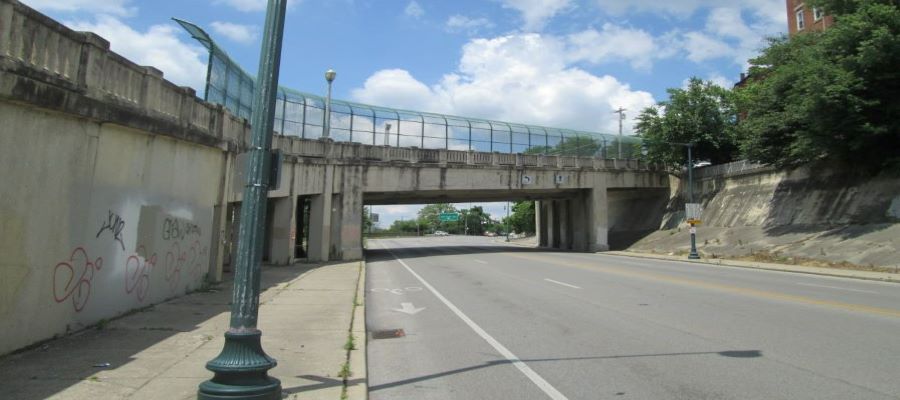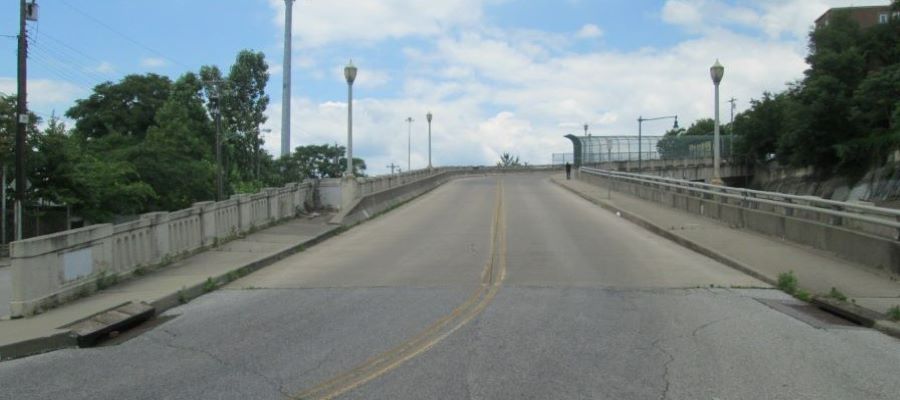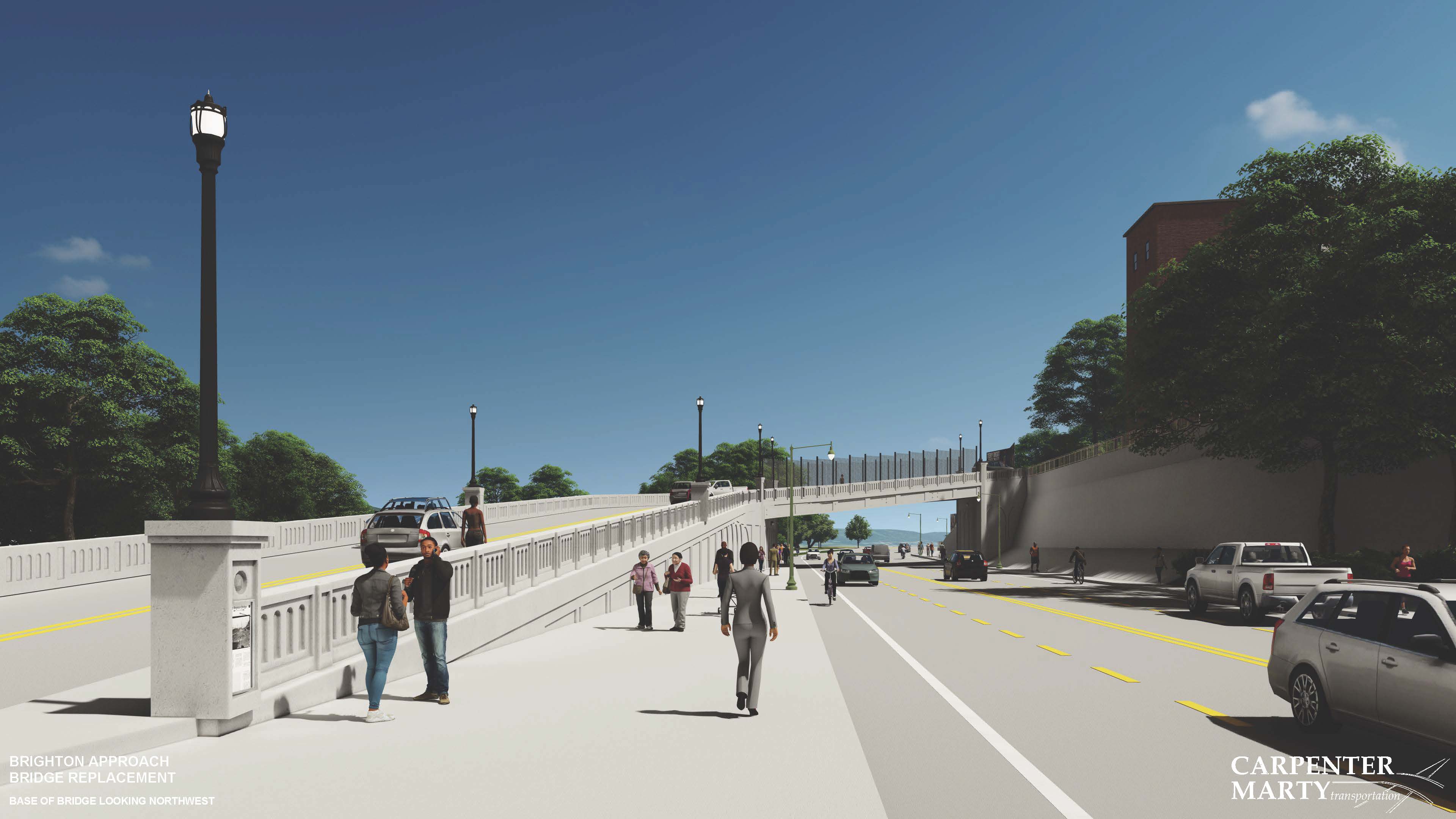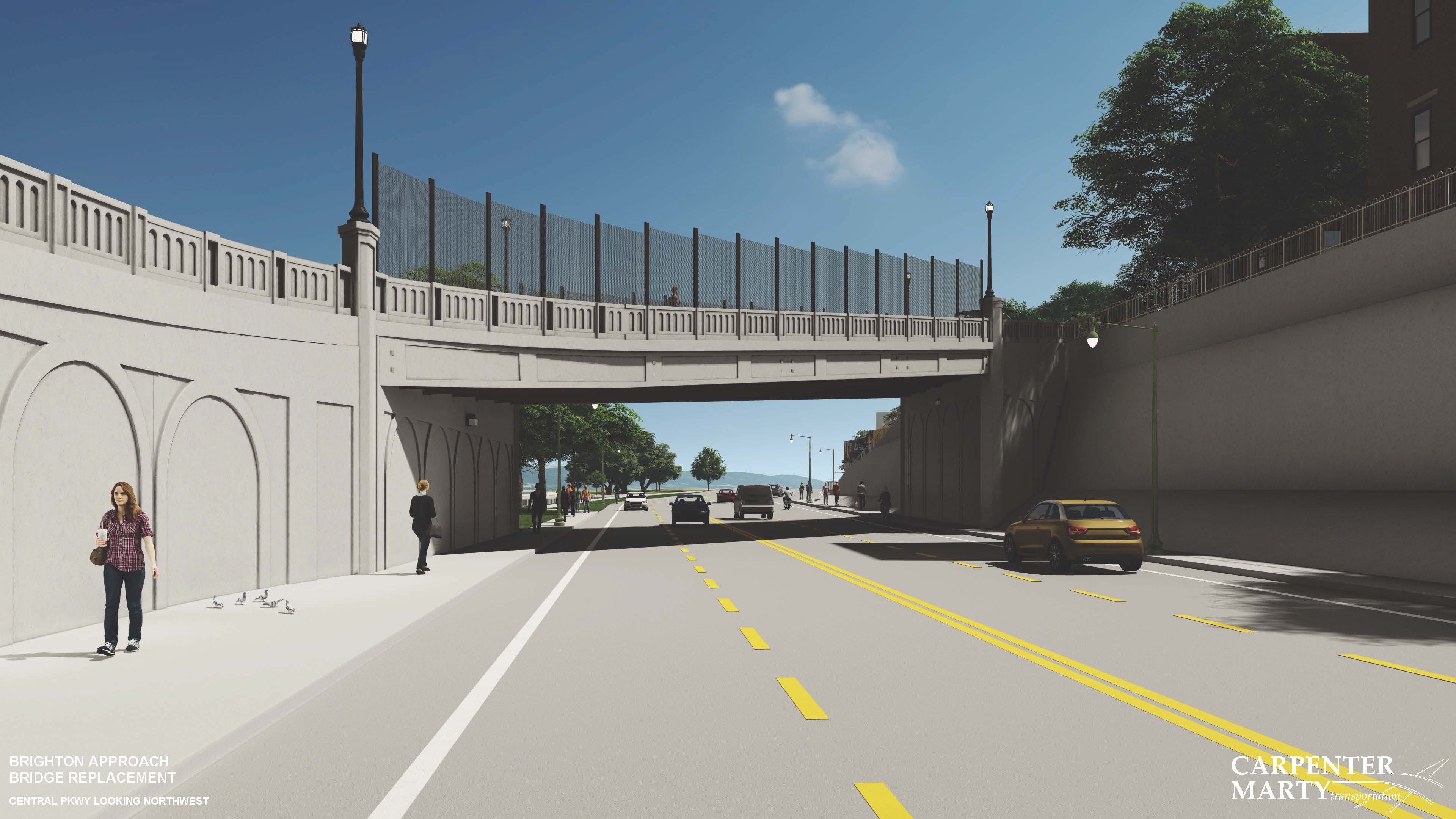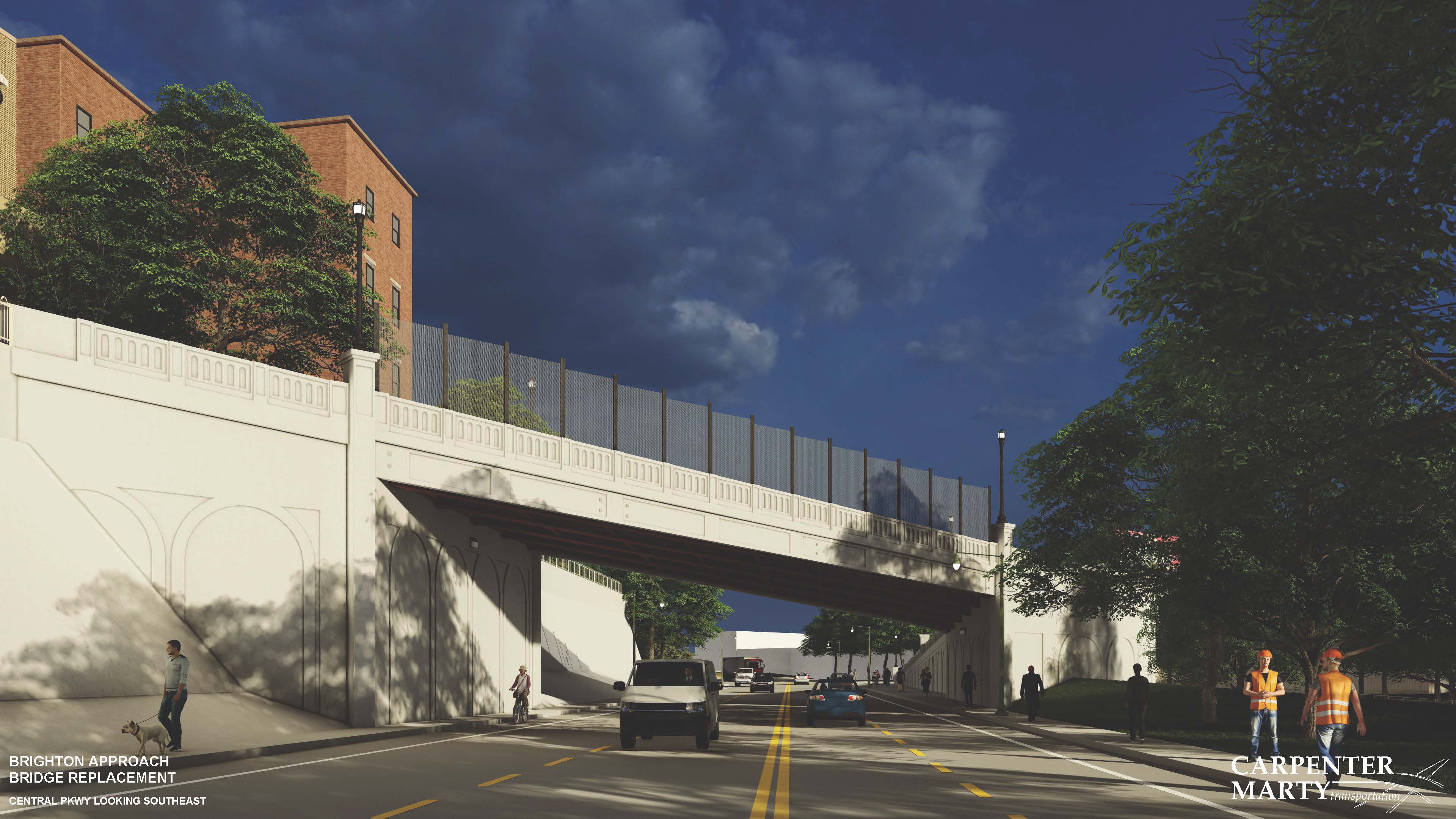Brighton Approach Bridge
Construction of the replacement Brighton Approach Bridge is scheduled to begin in summer 2024. The new span will serve vehicles and pedestrians.
The Cincinnati Department of Transportation & Engineering (DOTE) made the decision to replace the bridge after considering feedback from its engineering consultant via an Alternatives Evaluation Report and receiving input from area residents, community councils and a variety of stakeholders. We thank all stakeholders for your recent feedback.
The existing bridge was built in 1926 and has reached the end of its useful life. It is in poor condition with widespread deterioration.
The new bridge, which will be built in the same location as the current one, will continue to connect Central Parkway, Colerain Ave and Harrison Avenue at its south end and West McMicken Avenue at its north end, touching the West End, CUF and Over-the-Rhine (OTR) neighborhoods.
In addition, the new bridge also will:
- Maintain direct pedestrian and vehicle connections
- Improve pedestrian and bike access on Central Parkway
- Increase vertical clearance on Central Parkway
Please note: DOTE also is coordinating with upcoming adjacent projects on Central Parkway, including the Western Hills Viaduct replacement to the west and a streetscape along Central between Liberty and 12th streets to the east behind Music Hall in OTR.
Read more about the project via the following tabs:
Purpose
The purpose of the project is to improve the safety of the travelling public on Brighton Approach and Central Parkway within the limits of the Brighton Approach Bridge.
Need
The primary need for the project is to address the structural deficiencies of the bridge.
Secondary needs include:
- Eliminate the posted weight limits on the bridge.
- Increase the vertical clearance under the bridge to meet current standards.
- Eliminate support of the bridge on top of the existing abandoned subway tunnel.
- Improve pedestrian and bicycle safety and access along US 27/Central Parkway within the project area.
- Honor the historic nature of the bridge and surrounding buildings eligible for listing on the National Register of Historic Places.
- Preserve a connection across Central Parkway.
- Maintain traffic on Central Parkway during construction.
It may not be possible to address all of the secondary needs, depending on many factors, including feasibility, feedback from stakeholders and the public, and available funds.
The existing Brighton Approach Bridge was built in 1926 as part of the construction of Central Parkway and the Cincinnati subway. It has undergone multiple rehabilitations in the decades since, most recently in 1991.
Its condition rating is 4 on a scale of 0 to 9 per state and federal standards. Nine is the best condition rating and 0 is the worst. A rating of 4 is classified as "poor."
There is significant deterioration over large areas of the bridge’s structural support beams and columns, including, cracking, loosening and spalling (falling off) of the outer layer of concrete and rusting of the embedded reinforcing steel bars.
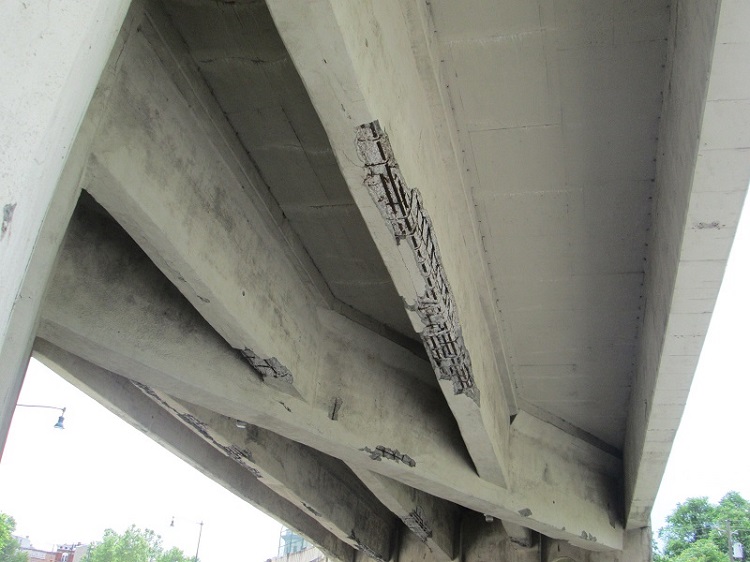
The city and ODOT perform regular inspections at least annually and the city performs routine maintenance that includes locating and removing loose concrete from the bridge's underside.
Due to this deterioration, and because the bridge wasn't designed to carry the heavier weight of today's vehicles, the current weight limit has been reduced by up to 30 percent, depending on the type of vehicle.
In addition to its poor structural condition, the bridge also contributes to safety and accessibility issues for pedestrians walking along Central Parkway.
The open area under the curve of the bridge is partially hidden from public view and isn't lighted. It also attracts trash dumping and homeless camps.
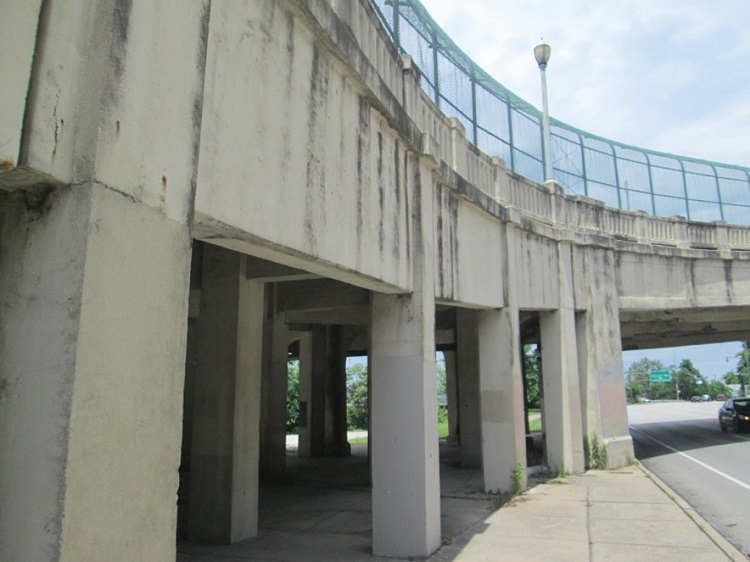
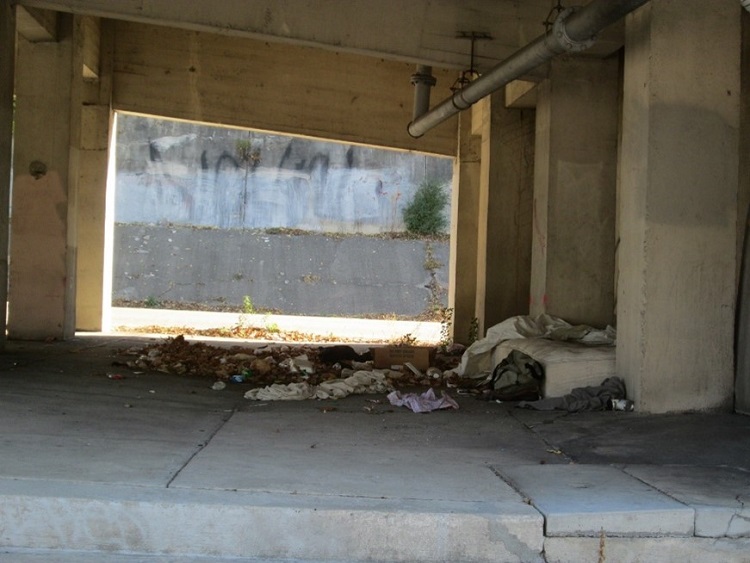
The area under the south curved portion of the bridge is partially hidden from public view, which creates a safety concern for pedestrians and an ongoing problem with trash dumping and homeless camps.
The main support piers on both sides of Central Parkway block the sidewalks. On the south side, pedestrians are forced to walk through the hidden area mentioned above, while on the north side the sidewalk narrows to less than two feet wide and is often littered with trash and debris.
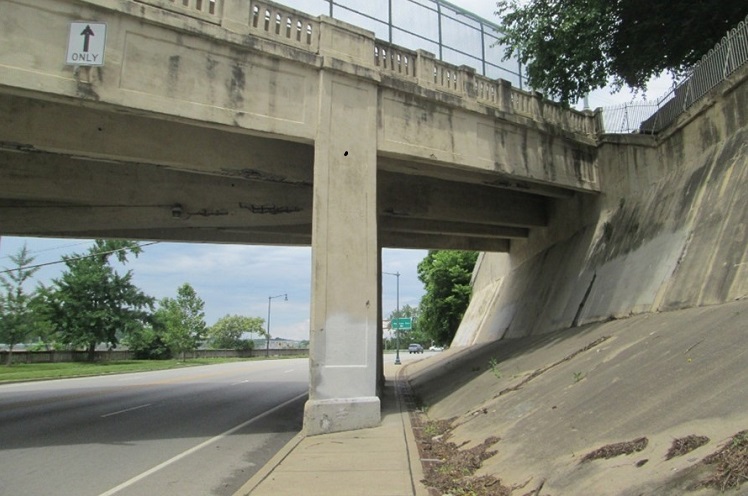
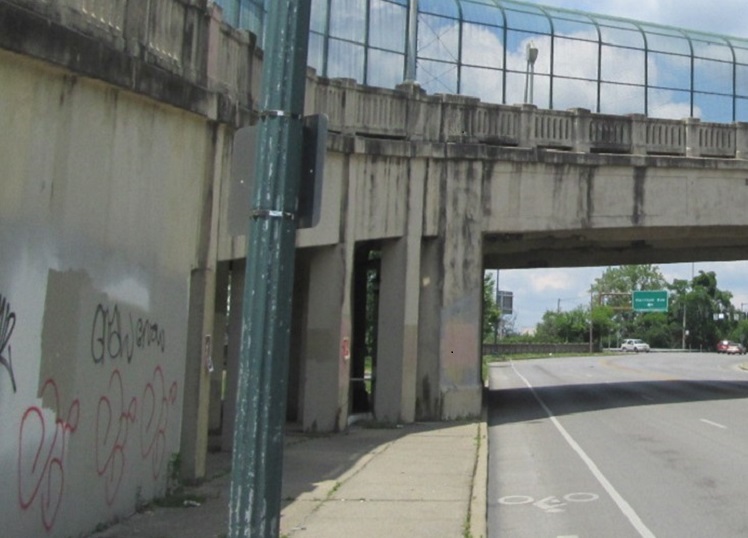
The vertical clearance over Central Parkway beneath the bridge is 13.5 feet, which is substandard. These is evidence of vehicles hitting the bottom of the bridge in the past.
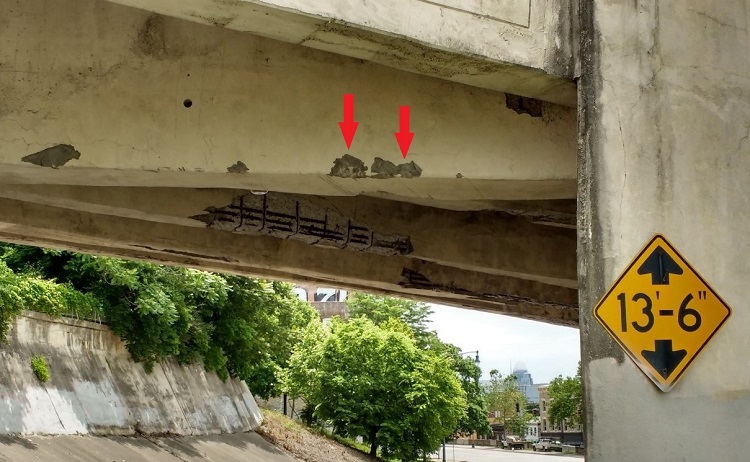
- Estimated Project Cost: $8 million
- Total funding secured:
- City of Cincinnati capital: $3.2 million
- Ohio Public Works Commission grants: $2.8 million
- Federal grants: $2 million
Q: What is the status of the Brighton Approach Bridge?
A: Built in 1926, the bridge is reaching the end of its useful life. Construction of a replacement bridge in the same location will get under way in early 2024. The new bridge will accommodate both vehicles and pedestrians.
Q: Did taxpayers have a say in the decision to remove or replace the bridge?
A: Yes. DOTE conducted a detailed study and obtained feedback from stakeholders and the general public in a variety of ways. We used that feedback to help us make the decision to replace the bridge.
Q: What options did DOTE/city consider?
A: We considered multiple options to replace the bridge, as well as an option to remove the bridge with no replacement. Please refer to the Proposed Alternatives report for more details.
Q: How are pedestrians affected by the changes to the bridge?
A: The new bridge will have a sidewalk like the existing bridge, so pedestrians will be able to cross over Central Parkway as they do currently. On Central Parkway beneath the bridge, the sidewalks will be widened and the bridge support columns moved back away from the parkway to provide improved, unobstructed passage.
Please note: During construction, the bridge will be closed to both cars and pedestrians and detours will be posted.
Q: What is the timeline to replace or rehab the bridge?
A: Construction will begin in spring 2024 and is expected to be completed in the fall of 2025.
Q: How much will it cost and who is paying for it?
A: The project is estimated to cost $8 million. The city is providing $3.2 million in funding. The state is funding $2.8 million and a federal grant covers the remaining $2 million.
Q: Is the Ohio Department of Transportation (ODOT) involved in the project?
A: Yes. ODOT is administering the federal grant money that is helping to pay for the construction of the project, helping to ensure that federal environmental requirements are being followed, and reviewing the project design for compliance with applicable standards.
Q: Is the current bridge safe to use?
A: It is safe for all vehicles that do not exceed the posted weight limits. The city and ODOT perform regular inspections and maintenance on the bridge.
Q: What is the bridge's condition rating?
A: Its condition rating is 4 on a scale of 0 to 9 per ODOT and National Bridge Inspection Standards. Nine is the best condition rating and 0 is the worst. A rating of 4 is classified as "poor."
Q: Are there weight limits on the bridge?
A: Yes. There are weight limits due to structural deterioration. The bridge wasn't designed to carry the heavier weight of today's vehicles. The current weight limit has been reduced by up to 30 percent, depending on the type of vehicle.
If you have comments or questions, please reach out by phone, email or U.S. mail:
Contact: Brandon Lecrone, Project Manager
Phone: (513) 352-2366
Email: brandon.lecrone@cincinnati-oh.gov
Address: 801 Plum Street, Suite 450
Cincinnati, Ohio 45202
Section 106 of the National Historic Preservation Act of 1966 requires federal agencies to consider the effects of their actions on historic properties. Part of that process includes consulting with other parties with an interest in the effects on historic properties, referred to as the "Consulting Party Process.
► how to become a consulting party
► application to become a consulting party
Please contact the project manager, if you have questions:
Contact: Brandon Lecrone, Project Manager
Phone: (513) 352-2366
Email: brandon.lecrone@cincinnati-oh.gov
Address: 801 Plum Street, Suite 450
Cincinnati, Ohio 45202
NEPA Participation Statement
The City of Cincinnati Department of Transportation & Engineering and its partners are following the requirements of the National Environmental Policy Act (NEPA) of 1969 for the Brighton Approach Bridge project.
Enforced by the Federal Highway Administration (FHWA), the purpose of NEPA is to ensure that the environmental consequences of a proposed project and its components are thoroughly evaluated and considered before any final decisions are made. NEPA also requires that the public be informed and has the opportunity to provide input as part of the decision-making process.
In Ohio, FHWA has granted the Ohio Department of Transportation authority to oversee adherence to NEPA requirements. Under this arrangement, ODOT assumes responsibility for compliance with environmental laws, rules and orders, interagency consultation, and any other environmental related actions for Ohio-based transportation projects. This assignment of responsibilities streamlines the federal environmental review process and gives ODOT project review and approval authority.
► more information about this process
Commitment to Public Involvement
To fulfill NEPA-based public involvement requirements, the City of Cincinnati will:
- Provide early and continuous opportunities for meaningful public involvement
- Provide adequate notice of public involvement opportunities and time for public review and comment at key transportation planning development milestones
- Provide reasonable public access to technical data and policy information
- Conduct public meetings at convenient and accessible locations and times
- Use visuals when feasible to describe the planning process and project information
- Make public information available in electronically accessible formats, whenever possible
- Demonstrate explicit consideration and response to public input received
- Seek out and consider the input of traditionally underserved populations, including low-income and minority households and populations with limited English proficiency; provide interpretation assistance when needed

